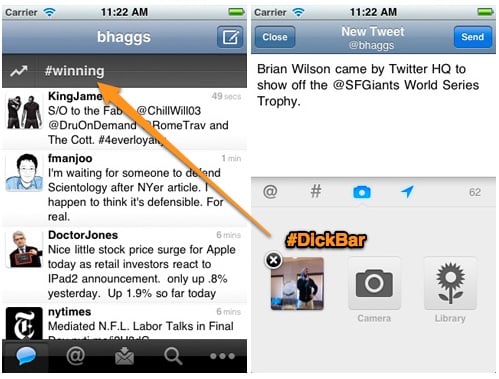Find Our Latest Video Reviews on YouTube!
If you want to stay on top of all of our video reviews of the latest tech, be sure to check out and subscribe to the Gear Live YouTube channel, hosted by Andru Edwards! It’s free!
Monday March 7, 2011 11:56 am
Why the Twitter Quick Bar (DickBar) is a bad move

Twitter users are up in arms over the Twitter Quick Bar, which pundit John Gruber termed the "Dickbar" after Twitter CEO Dick Costolo, a forced trending topics bar appearing at the top of the new iPhone Twitter client. To some extent, this is just whining—there are so many Twitter clients out there, it's easy to find one with the layout you prefer. But it also shows the bigger problem with Twitter's trending topics, which the service has managed very poorly since it became a mass medium.
Real estate is precious on small phone screens, and users demand that every pixel be spent on something relevant. People are willing to make an exception for ads on free apps; after all, developers need to pay the bills. But the trending topics tend to spotlight micro-communities that don't overlap much with each other. As an optional means of discovery, they're mildly interesting. Forced upon us, they bombard us with irrelevant data that breaks down our carefully constructed social-networking comfort zones.
Twitter started out, years ago, as a social service for a common techno-clique who all attended the South by Southwest music conference, so trending topics made sense. But since then, it's expanded and fragmented into a mass medium made up of non-overlapping micro-communities. Everybody uses Twitter differently, but almost everybody consciously or unconsciously cultivates their feed. The trending topics are like a loud stranger wandering into your invitation-only party.
The Quick Bar is really about advertising, of course. Twitter is trying to make money off "promoted topics" for movies and consumer products. But I don't think that's the source of the real anger here. Most people see ads as a necessary evil so we can get free stuff. But we don't understand why our screens are full of jibber-jabber about Brazilian TV presenters.
Google's AdSense is less annoying because it actually makes an effort to be relevant. Twitter is being either lazy or Utopian here. If they're lazy, they need to stop. If they're being Utopian, they need to understand that it's a big world with a lot of non-overlapping interests, and the fact that Justin Bieber has created a large micro-community doesn't mean that Bieber's micro-community is relevant to, say, fans of Indonesian jazz festivals.
Many young (mostly) African Americans log on to trade quips in "hashtag games" like #manlawmonday; they may have zero in common with the Justin Bieber fans who usually dominate one or two trending topics, and they almost certainly have no overlap with the Korean pop stars who grab a topic or three most days. That also leaves those of us who aren't into K-pop, Bieber or Indonesian jazz festivals mildly annoyed by the wasted space.
This is exacerbated because certain micro-communities tend to use the trending topics as their playgrounds. Indonesians, K-pop fans, people who watch British reality TV shows, Bieber fans and those hashtag game players are (I think) overrepresented when it comes to overall Twitter activity. There's no conspiracy there—other communities just don't see "trending" as socially important as those groups do. It's a pity, because trending topics could be a much more powerful means of discovery on Twitter.
Twitter can solve this by rethinking trending topics. Trending topics need to be topics relevant to you: common phrases within your social graph of followers and followed, probably within two or three degrees of association. That would give me a lot less Bieber and a lot more iPhone, probably, but it wouldn't totally kill discovery: once you get a degree or two away from yourself in your social graph, you'll find people with more diverse interests.
For now, I'd advise people to use a different Twitter client (or a different platform). I've been happy with TweetDeck on both the iPhone and Android. Right now I'm playing with Spaz on WebOS. Twitter's open API is something the service has gotten absolutely right; if users flee the Quick Bar, the company will know it has to change.
This article, written by Sascha Segan, originally appeared on PCMag.com and is republished on Gear Live with the permission of Ziff Davis, Inc..
Latest Gear Live Videos
Advertisement
Advertisement
Advertisement
© Gear Live Inc. {year} – User-posted content, unless source is quoted, is licensed under a Creative Commons Public Domain License. Gear Live graphics, logos, designs, page headers, button icons, videos, articles, blogs, forums, scripts and other service names are the trademarks of Gear Live Inc.











